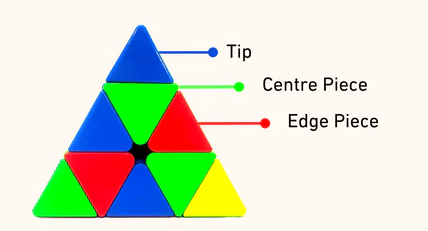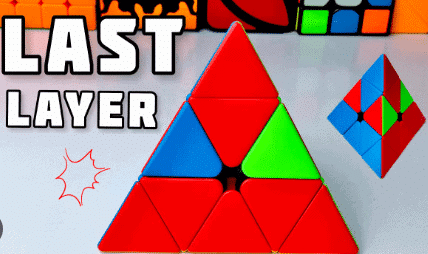Worksheet Solutions: Pyramid Cube | Solve Like a Pro: Rubik Cube Tutorials - Class 6 PDF Download
Fill in the Blanks
When solving the Pyraminx, the first step is to align all the __________ of one color on the same side.
Ans: centers
Explanation: The Pyraminx has four center pieces, one for each face. The first step in solving it is to get all the centers of one color on the same side to create a foundation for solving the puzzle.The algorithm used for inserting a left-side edge piece in the first layer is __________.
Ans: L R’ L’ R
Explanation: The Left Insert Algorithm helps place an edge piece correctly on the left side when solving the first layer of the Pyraminx. It ensures that the piece is moved into its correct position without disrupting other solved parts.The Counterclockwise Cycle Algorithm moves three edge pieces in a __________ direction.
Ans: counterclockwise
Explanation: The Counterclockwise Cycle Algorithm is used to rotate three edge pieces in a counterclockwise manner, helping position them correctly in the last layer of the Pyraminx.When solving the Pyraminx, it is recommended to be __________, meaning you don’t always start with the same color.
Ans: color neutral
Explanation: It is recommended not to stick with any specific colour for starting the Pyraminx.To solve the last layer of the Pyraminx, you often need to use special algorithms like the __________ Algorithm to flip incorrectly placed edges.
Ans: Two Flip
Explanation: The Two Flip Algorithm is specifically used when two edges in the last layer are flipped incorrectly. It helps correct these flipped edges without affecting other parts of the solved Pyraminx.
Multiple Choice Questions
1. What is the first step in solving the Pyraminx?
(a) Solve the last layer
(b) Solve all the tips first
(c) Get all the centers of one color on the same side
(d) Solve the first side edges
Ans: (c) Get all the centers of one color on the same side
Explanation: The first step in solving the Pyraminx is to align all the center pieces of one color on the same face. This creates a foundation for solving the rest of the puzzle. Unlike the 3x3 Rubik’s Cube, the centers of a Pyraminx can move, making this step necessary.
2. What is the algorithm used for the Right Insert when solving the first side edges?
(a) R’ L R L’
(b) L U’ L’
(c) L’ U L
(d) R U R’
Ans: (a) R’ L R L’
Explanation: The Right Insert Algorithm (R’ L R L’) is used to correctly place an edge piece into its correct spot on the right side when solving the first layer. This ensures that the piece is inserted without affecting the solved center and tips.
3. Which of the following is NOT a part of the last layer solving algorithms?
(a) Two Flip
(b) Clockwise Cycle
(c) Counterclockwise Cycle
(d) First Side Centers
Ans: (d) First Side Centers
Explanation: The First Side Centers are solved at the beginning of the solve, not in the last layer. The last layer algorithms include the Two Flip Algorithm (to fix flipped edges), and the Clockwise and Counterclockwise Cycle Algorithms (to move edges around).
4. What is the best approach for solving the tips of the Pyraminx?
(a) Solve them all at the beginning
(b) Save them all for the end
(c) Solve as many as possible throughout the solve
(d) Ignore the tips until the cube is solved
Ans: (c) Solve as many as possible throughout the solve
Explanation: It is more efficient to solve the tips throughout the solve rather than waiting until the end. If all tips are left for the final step, it may require extra moves, slowing down the solving process. Ideally, no more than two tips should be left for the final step.

5. Why is it beneficial to be color neutral when solving the Pyraminx?
(a) It allows for faster solves
(b) It makes the puzzle easier to hold
(c) It reduces the number of required algorithms
(d) It eliminates the need to solve the centers
Ans: (a) It allows for faster solves
Explanation: Being color neutral means that you don’t always start with the same color. This allows you to pick the easiest starting face, making the solution more efficient and potentially reducing the number of moves needed.
True/False Questions
True or False: It is best to always start solving the Pyraminx with the same color.
Ans: False
Explanation: It is recommended to be color neutral, meaning you should not always start with the same color. Being color neutral allows for a more efficient and flexible solve because you can start with the easiest face instead of limiting yourself to just one color.True or False: The Two Flip Algorithm is used to solve the last layer of the Pyraminx.
Ans: True
Explanation: The Two Flip Algorithm (R’ L R L’ U L’ U’ L) is specifically used in the last layer to correct flipped edges. It helps in fixing the last layer edges without disturbing the already solved parts of the puzzle.True or False: The Clockwise Cycle Algorithm for the last layer is R U' R' U' R U' R'.
Ans: True
Explanation: This algorithm is used to cycle three pieces in a clockwise direction in the last layer. It is one of the key algorithms for solving the Pyraminx and helps in positioning pieces correctly.True or False: The Right Insert Algorithm is L R’ L’ R.
Ans: False
Explanation: The correct Right Insert Algorithm is R’ L R L’. This algorithm is used to insert an edge piece into its correct position when solving the first side edges. The given algorithm (L R’ L’ R) is incorrect because it does not perform the required move correctly.True or False: The best strategy is to leave all the tips for the last step of solving the Pyraminx.
Ans: False
Explanation: It is not efficient to solve all the tips at the end. Instead, it is best to solve as many tips as possible throughout the solving process to save time and avoid extra moves at the end. Ideally, no more than two tips should be left for the final step.
|
23 videos|24 docs
|
FAQs on Worksheet Solutions: Pyramid Cube - Solve Like a Pro: Rubik Cube Tutorials - Class 6
| 1. What is a 4x4 Rubik's Cube and how does it differ from the standard 3x3 cube? |  |
| 2. What are some common methods for solving a 4x4 Rubik's Cube? |  |
| 3. Can you provide tips for beginners trying to solve a 4x4 Rubik's Cube? |  |
| 4. What are the most common mistakes made when solving a 4x4 Rubik's Cube? |  |
| 5. How long does it typically take to learn to solve a 4x4 Rubik's Cube proficiently? |  |




















